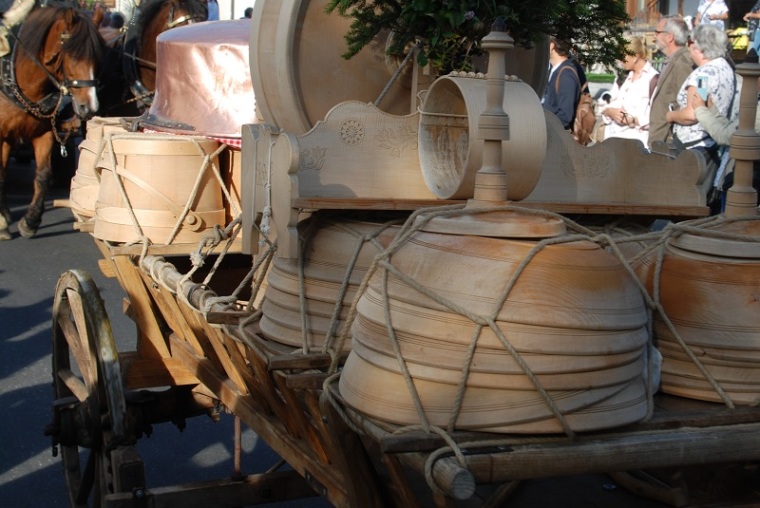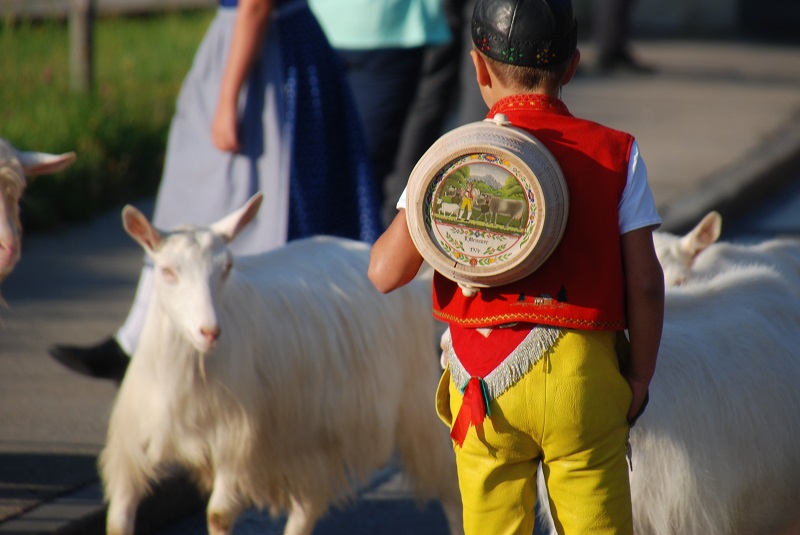
There are cow parades at the end of summer, and then there is the Alpabzug in Appenzell. In the most conservative cantons in Switzerland, where voting is still done by raising hands in the voting square of the town in some places (and women had to fight for much of the 20th century to join in the voting), tradition is on full display when the cows come home in a carefully choreographed ritual. Ahead of the cows comes a young boy wearing yellow pants and a red vest, a little leather cap on his head and a dangling earring in his right ear. He carries a richly decorated Fahreimer, a wooden bucket, on his shoulder.

Then come the Appenzell goats, ushered along by one or more girls who control them with twigs and branches. Next up are the three lead cows, with bells that are carefully calibrated to be in harmony. They are preceded by a Senn, a cowhearder, in the same dress as the young boy. Behind them are three Sennen, also with red vests but wearing brown pants. These men sing or jodel along with the bells, and keep an eye on where the cows go. This is no trivial matter because some of the cows just do not follow protocol all that well.


The herd follows, cows and calves, and assorted humans to keep them in line. Next is a horse-drawn cart, the Ledi, which carries all the implements needed for cheese making. Much of these are no longer in use, but they do make for a beautiful display. Concluding the procession is the owner of the cows, in white shirt, often with bib suspenders, and brown pants. He may have his son along, and his dog, and sometimes he’ll pull a bull along. There are variations – in Appenzell itself I saw a teenage girl pulling the bull (“I cannot believe dad is making me do this” on her face), and you may see some chickens carried along on a wagon, or a pig or so. But mostly, the order is adhered to and everyone goes about it with a curious mix of cheerful solemnness.





We went to Urnäsch in the Canton of Appenzell Ausserrhoden, while overnighting in the canton next door: Appenzell Innerrhoden. Not an unimportant detail, as our stated goal is to spend time in every Swiss canton in the course of the time we will spend here. Urnäsch is small and everyone seems to know each other, and everyone is out to cheer on their farming neighbors. I think there were people along the way who did not just greet the farmer and his family, but also individual cows. There was a market set up where one could buy sausages, Appenzell folk art and – you guessed right! – cheese. In the main street is a delightful museum that tells stories of the very rich folk art and traditions of the area. It is house in an old building with lots and lots of rooms, so you are clambering up and down stairs, watching you head under the low ceilings all the while ooh-ing and aah-ing at the colorful art that fills each room. I am not normally a fan of these attic-like museums, but this one absolutely works – I can only recommend it.

Our day continued up to the nearby Ebenalp to what is perhaps the most famous restaurant in all of Switzerland: the Berggasthaus Aescher, squeezed onto a narrow ledge under an enormous overhang. As tourist sites go, it does get a lot of traffic, but we were comfortably seated and found the food, service and views absolutely worth the climb.

The next morning, our tradition-filled extravaganza continued as we saw local women in traditional dress enter the church across the street from our hotel. Appenzell is easily one of the most picturesque of all Swiss cantons – a living, breathing, voting postcard.

